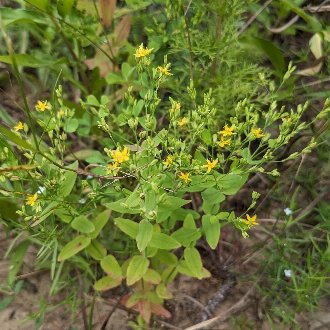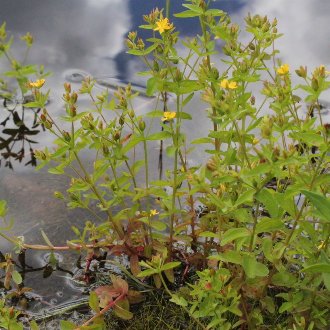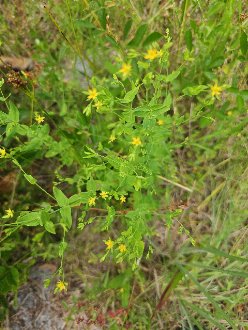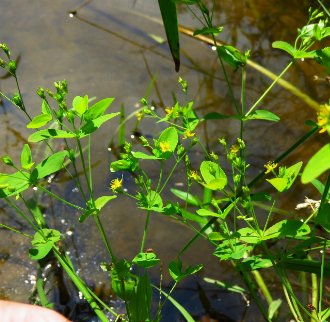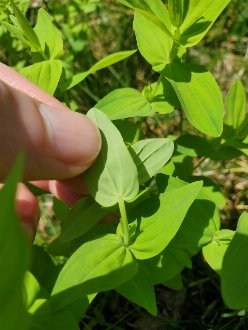Dwarf St. John's Wort (Hypericum mutilum L.)
Also known as dwarf st. Johnswort.
Two subtaxa of this species are recognized; FSUS considers them varieties but FNA and POWO consider them subspecies.
↑Summary
A small annual or short-lived perennial of moist to wet sites, slightly preferring acidic conditions, native to eastern North America.
↑Range - Expand
| Legend | Color |
| Native | |
| Introduced | |
| Native or Not Present | |
| Introduced or Not Present |
This tentative map is based on our own research. It may have limited data on Canada and/or Mexico, and there is some subjectivity in our assignment of plants as introduced vs. expanded. Read more in this blog post.
Although this plant occurs somewhere in each of these regions, it may only occur in a small part of some or all of them.
↑Similar Plants
↑Habitat
Dwarf St. John's wort is found in a wide variety of sunny to lightly shaded moist-to-wet habitats. Natural habitats include open floodplain forests, swamps, seeps and springs, marshes, wet meadows and wet to moist prairies, and shores of lakes, ponds, rivers, small depressions in open forests or barrens, or streams, especially where the shoreline has slightly receded during the growing season. Anthropogenic habitats include ditches, depressions in sandy paths, and abandoned fields. In the east of its range where it is more abundant, it can also occur in wet spots in lawns and gardens.
It can grow on a wide range of soil pH but prefers acidic soils, which may be why it is uncommon to missing from much of the Mississippi Alluvial Plain. In the west of its range, where it is less common, it restricted to acidic soils, often on rocky or especially on sandy substrates.
In the east, it is more common and occurs in a wider range of habitats, occurring in nearly any type of open wet area, and tolerating a wider range of soil textures, including sandy, rocky, silt, clay, and muck.
↑Life Cycle
Dwarf St. John's wort is an opportunistic annual to short-lived perennial that grows during the warm season. Seeds germinate in late spring when temperatures warm, and foliage of established plants emerges around the same time.
Its size, growth habit, and lifespan are highly dependent on conditions. The bloom period is long, often 2-3 months or even longer in parts of the south. The plant opens new flowers each day in early morning, and flowers are usually closed by mid-afternoon.
First-year plants usually flower and produce seeds, but often not as prolifically as established plants. Established plants form a clumping habit, sending up more stems each year, and often growing slightly taller.
The entire plant, including foliage, stems, and seed capsules, turns a dramatic red color in fall.
We could not find information on the seed distribution mechanism, but the seeds are likely dispersed in part by water, and are also small enough to blow around in the wind in dry conditions. The seeds also are able to stick to animals; birds that forage in muddy shorelines may be particularly important in spreading this plant to new sites. We could not find specifics on the duration of persistence in the soil seed bank, but a number of studies have found that this species is present in the soil seed bank and it may germinate from the seed bank in response to changes in water levels that expose new habitat that has not been suitable for a number of years.
As a small plant that does not reproduce vegetatively over long distances, plants can experience mortality from changing water levels, often in response to different year-to-year weather patterns, and can be killed if its habitat becomes too flooded. Plants are surprisingly drought resistant for a plant that primarily grows in wetlands, and towards the drier end of this species' growing conditions, it not usually killed by drought but rather by shading from taller, more aggressive plants as the soil becomes less saturated and better aerated.
↑Faunal Associations
Mammalian herbivores usually avoid this plant, which contains toxins that can both cause gastrointestinal irritation, and photosensitivity. The flowers lack nectar, but attract a variety of small pollen-seeking bees, flies, and beetles. A large number of insects feed on this plant, mostly ones that specialize in the Hypericum genus, including leaf beetles, a weevil, gall flies, plant bugs, aphids, spittlebugs, leafhoppers, armored scales, thrips, and various moths.
We could not find many details on which insects eat this species specifically, with the exception that the gray half-spot moth (Nedra ramosula), which feeds on Hypericum sp., has been recorded eating this plant.
↑Control
This plant is weedy and likely has invasive potential outside its native range; some other Hypericum species have become invasive when introduced to new areas. Due to this plant's small nature and potential to form a persistent seed bank it may be hard to remove once introduced, and it is thus important to avoid spreading this plant.
↑Uses
This plant is little utilized for any reason, but it can be used as a garden plant, where it is valued for its small size, attractive foliage, cute flowers, long bloom period, resistance to deer and rabbits, and dramatic fall color. It is easy to grow in gardens and can survive in slightly drier conditions in gardens than it would in the wild, but it can sometimes be unpredictable, as individual plants are short-lived and it self-seeds prolifically and will usually move into its preferred locations.
This plant can also be used in ecological restoration projects, to stabilize soil in areas where moist shorelines have been exposed; it is most useful in areas with acidic substrates not suited for larger, more aggressive plants.
It is usually easier to establish from seed because plants are so small that transplanting them can be labor-intensive.
↑Related Plants
There are a large number of Hypericum species, mostly native but some introduced, that overlap with this one in range. No other plants in the Hypericaceae family occur in North America. This species is currently placed in the Subsection Knifa of the Trigynobrathys section of the Hypericum genus.
Although most of the Knifa section is native to North America, one analysis placed this species as closest-related to Hypericum japonicum, which does not occur in North America. After that it is thought to be next-closest-related to northern st. john's wort (Hypericum boreale), followed by Hypericum lalandii, which does not occur here, the two native species large st. johnswort (Hypericum majus) and lesser canadian st. johnswort (Hypericum canadense), and Hypericum silenoides which is native to Mexico southward.
↑Links & External Resources
• Hypericum mutilum (Dwarf St. John's Wort) | Illinois Wildflowers (About This Site)
• Hypericum mutilum (dwarf St. Johnswort) | USDA PLANTS Database (About This Site)
• Hypericum mutilum | Go Botany (About This Site)
• Dwarf St. John's Wort | iNaturalist (About This Site)
• Hypericum mutilum | Biota of North America Project (BONAP) (About This Site)
• Hypericum mutilum | NatureServe Explorer (About This Site)
• Hypericum mutilum | Flora of North America (About This Site)
• Hypericum mutilum | Missouri Plants (About This Site)
• Dwarf St. Johnswort | Maryland Biodiversity Project (About This Site)
• Hypericum mutilum L. | Plants of the World Online (POWO) (About This Site)
• Hypericum mutilum L. (Dwarf St. John's-wort) | Digital Atlas of the Virginia Flora (About This Site)



